- Home
- international
- article
- 10 tiny house owners reveal what it's like to live in a downsized space during the coronavirus pandemic
10 tiny house owners reveal what it's like to live in a downsized space during the coronavirus pandemic
Frank Olito,Samantha Grindell

- People who live in tiny homes on wheels are struggling to find places to park their vehicles during the coronavirus pandemic.
- Other tiny home owners are having difficulty storing food and paper goods because of their limited space, and they're feeling isolated as they social distance.
- But some in the tiny community feel like their lifestyles have prepared them for the pandemic, as they're used to living with less.
- Visit Insider's homepage for more stories.
The coronavirus pandemic has impacted millions of people around the world, and those who live in tiny houses are no exception.
Tiny house owners are in a unique situation when it comes to social distancing. They're spending most of their time in 400 square feet or less, dealing with limited space, and suffering from lack of resources. Some tiny house owners, however, feel they are better off in their small homes.
Here's how 10 tiny house owners are dealing with the coronavirus lockdown.
Read the original article on InsiderWhitney Leigh Morris and Adam Winkleman also think their sustainable lifestyle prepared them to self-isolate in their 400-square-foot tiny house in California.
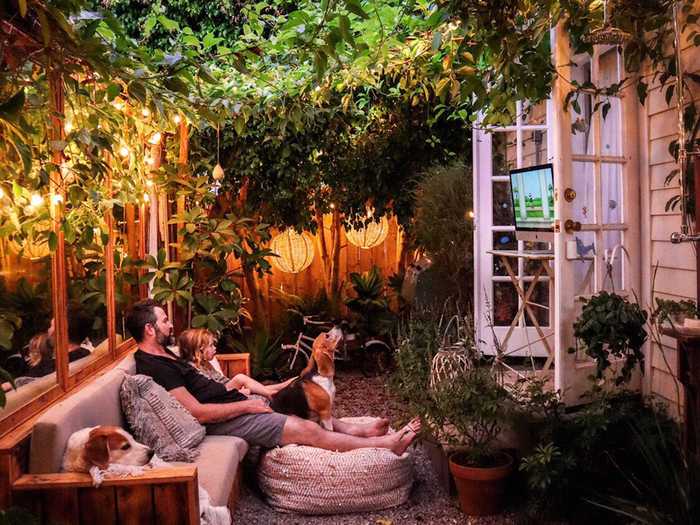
Morris and Winkleman have both been working from home in their cottage home for years, so they didn't have to change their day-to-day much at all, aside from forgoing the walks to the park they used to enjoy with their son. Morris has even been posting tips on working from home in a small space on her blog.
Morris also told Insider she thinks their commitment to sustainability within their small space has made isolating themselves easier. "For years we've been using reusable items in lieu of disposables, so there was zero need for us to buy or hoard items such as toilet paper," she said, freeing up space in the home for them to store food.
Living near other tiny homes has helped Morris and Winkleman feel less isolated in the pandemic as well. "We're surrounded by three small homes from the '20s (just like ours), and through windows, over fences and from rooftops we keep up with our neighbors daily," she said.
The sense of community is getting them through this.
Similarly, Dolly Rubiano, who lives in a tiny home on wheels in Australia, feels that her normal day-to-day prepared her for the pandemic.
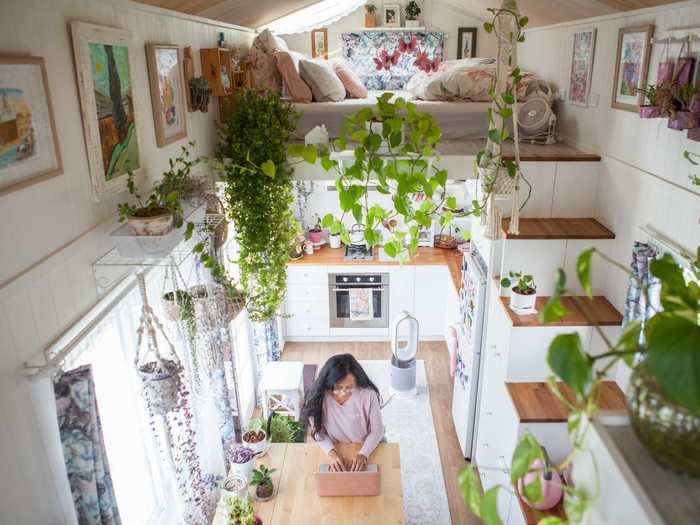
"My tiny home is the most sanitized place on Earth for me right now," Rubiano told Insider.
Rubiano said that she has to empty her compost toilet once a week instead of every other week because she's working from home now. But she has space to stock up on supplies for a month at a time, and she feels safer in her home since she's the only one going in and out. Plus, Rubiano said she can stay connected with her loved ones through technology, which is her go-to means of communication when there isn't a pandemic.
"Self-isolation and social distancing are not that different from what I've been doing for the last two and a half years living in my tiny home," she said. "Welcome to my world."
Zac and Katie Ruiz, who live in a 300-square-foot tent with their sons, said they are particularly thankful for their outdoor shower right now.
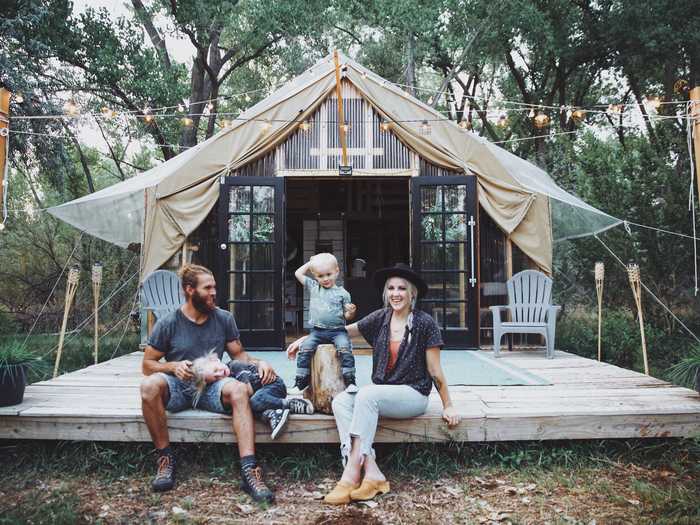
The family of four based in New Mexico has to shower at gyms or family members' homes in the winter, but the pandemic didn't hit their area until it was warm enough to use their outdoor shower.
Zac Ruiz told Insider that they feel like their lifestyle actually prepared them for self-isolating. The couple already works from home, they homeschool their children, and they tend to keep a stockpile of food on hand anyway.
They also have a well on their property, and they recently bought chickens, which makes it easier for them to feed themselves. The only thing they've really had to change is what they eat. "Usually we buy a lot more fresh vegetables and stuff like that and store them in our fridge, but we've always had our process down to minimize exactly what we need for a week," Ruiz said.
They're worried about how the pandemic will impact their businesses, but on the whole, the Ruiz family is feeling like the pandemic has reinforced that living tiny is the right choice for them.
Beka and Nathan Watson live in a 72-square-foot van in California, and they, too, had to find a new place to shower when their gym closed.
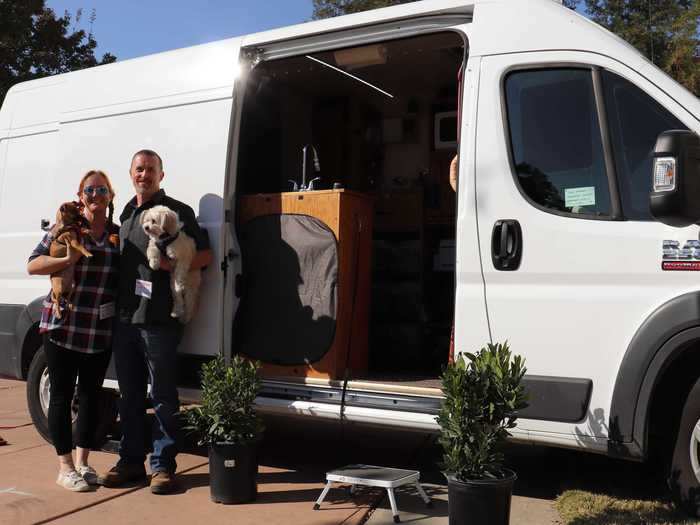
Beka and Nathan Watson are both nurses, so they are at the forefront of battling the coronavirus. When they aren't at the hospital, they are living in a van that they turned into a tiny house.
Like Stephens and Parsons, they usually shower at the gym, so now they have to shower at the medical facilities where they work.
Aside from that, Nathan Watson said they are happy to have a home that can easily go anywhere.
"There's a huge perk when sheltering at home when that home takes us through the drive-thru or overlooks a beautiful lake with a sunset," he told Insider.
Alexis Stephens and Christian Parsons are living in a 130-square-foot tiny house while on lockdown, and they also had to come up with creative ways to store their food.

Alexis Stephens said she and her partner bought triple the amount of food they regularly buy to stockpile during the lockdown. This created a problem for them because they have very limited storage in their tiny house, which is in central Oregon. The couple decided to buy a cooler that sits outside their house to store some milk and other refrigerated items. They also store some food and drinks in their shower to save space.
The shower is another challenge they're dealing with, Stephens said. They usually shower at the gym because it's easier, but now that gyms are closed they have to shower at home. This means they have to take out all the food that is stored inside the shower every time they need to bathe.
"My boyfriend and I have five years working and living tiny together. So luckily, we're used to spending most of our time only a few feet from each other," Stephens told Insider. "But we are missing our regular little trips to the gym and coffee shop, which typically gives us such a refreshing change of scenery. For now, daily walks with our dog are vital to our overall happiness. Importantly, we have never been so grateful for our cozy recession-proof tiny home."
Sam Cosner and Tim Davidson, who live in a tiny house in Florida, are struggling with storage and working from home in a small space.
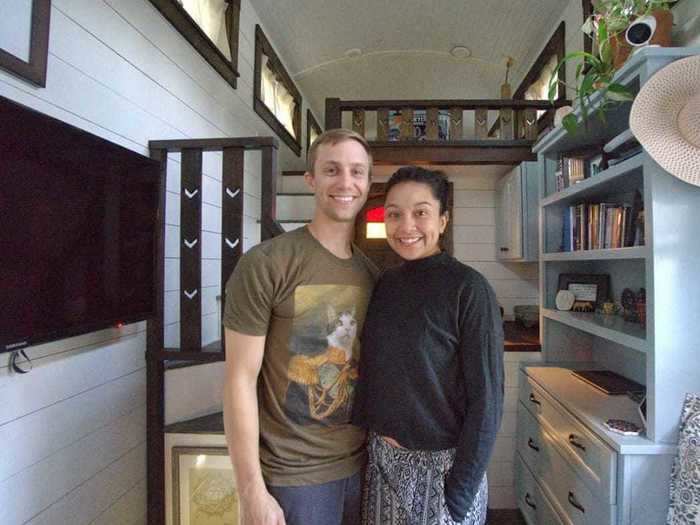
Located in Sarasota, Florida, Sam Cosner and Tim Davidson have been living in a tiny house since 2017, so they've adapted to living in a small space. Recently, however, they have been presented with a whole new set of challenges. Mainly, they are struggling to find places to store all the extra food they bought.
They are also having to cook a lot more in their tiny house since restaurants are closed. The couple said this is especially difficult to do in their tight space. But the challenges don't stop there.
"Working from home has been challenging at times," Cosner told Insider. "We have struck a rhythm, but it was hard at first to find a comfy spot to sit for a full shift. It has also been interesting to stick to a workout routine in a tiny home."
Bela and Spencer Fishbeyn also left their 300-square-foot tiny home during the pandemic because Bela is pregnant.
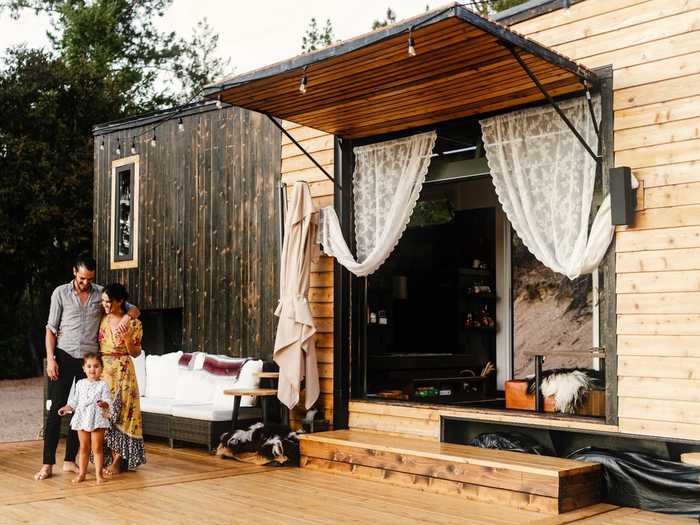
The Fishbeyns felt like their tiny home would have been able to accommodate them during the pandemic if necessary, as there's room to store supplies and their home sits in an isolated forest area, which would keep them safe. But because of Bela's pregnancy, they decided it would be better if they were closer to family.
The couple and their daughter, Escher, are used to leaving their California tiny home, as they often travel in a van and rent the home out to people throughout the year. But this time, they'll be staying with family in North Carolina through at least August, when Bela is due to have their second child.
"While packing up, we didn't know when we'd be able to see our home again," Bela Fishbeyn told Insider. "It's difficult to admit, but we really don't know when we'll go back to our tiny house. An airport is just about the last place we want to go to these days."
Destiny and Adam Clayton also had difficulty finding places to park their refurbished RV so ultimately decided to stay with family. Storing supplies was a problem for them as well.

The Claytons became alarmed when RV parks and campgrounds around the country started closing, as they knew they wouldn't be able to roam freely as they normally do.
They were also worried about running out of supplies on the road, particularly propane, which heats the RV and enables them to cook while they drive. They also didn't have room to store food and supplies for more than a week at a time in the RV, so they decided to stay at a family member's home in North Carolina until the virus is under control.
The pandemic has also impacted their livelihood, as the Claytons' primary source of income is from wedding photography. As thousands of weddings are postponed, they're finding themselves out of work and unable to live in their home.
But the biggest impact they feel is the emotional toll of not being able to rely on their tiny living community. "A lot of people that travel or live tiny depend on community and relationships," Destiny Clayton told Insider. "It's a very lonely lifestyle if you don't get to go out and meet people."
Like the Woods, retiree Keri Gailloux is struggling to find a place to park her school bus-turned-tiny house during these strange times.
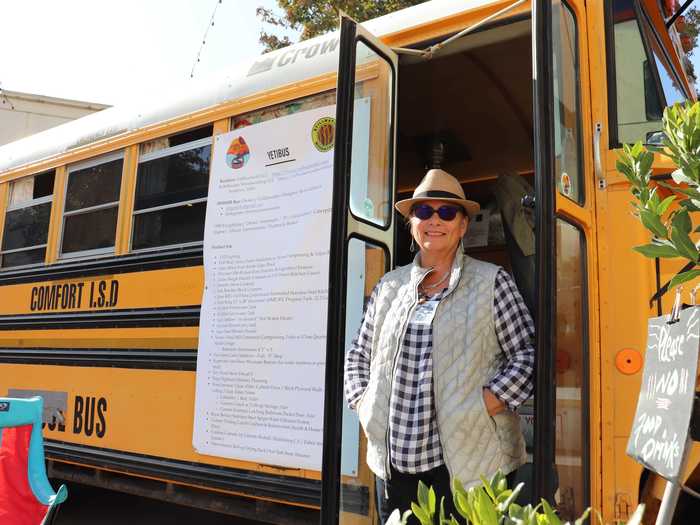
Keri Gailloux is a retiree traveling the country in her converted school bus. Typically, she parks her bus in public parks, but she has run into issues recently. She had an 11-day reservation in Mustang Island Park in Texas, but she said she was asked to leave because the park was closing for lockdown. Gailloux said she had to beg the park ranger to allow her to stay for a couple of days, as she had nowhere else to go. She feared she would have to be on the open road, increasing her chances of contracting the coronavirus. She described the incident as her "lowest point."
Eventually, she said she was able to convince the ranger to allow her to stay a couple more days while she booked a new location at a different park. In the end, it worked out, but Gailloux continues to be wary about traveling in her tiny house during this dangerous time.
"People are gathering in the parks as if everything is normal," Gailloux told Insider. "I keep to myself or with my friend. We have been hopscotch traveling over the last few months. We are careful but it only takes a touch or a sneeze or an inadvertent hug to make one sick. My biggest fear is to be sick, alone with my dog in my bus. What if I'm unable to drive to a hospital or clinic? I'm afraid of gas pumps, I'm afraid of ignorance, I'm afraid I will die and my dog will suffer."
Lindsay Wood and her husband are struggling to find a place to park their 300-square-foot tiny house in the middle of a lockdown.
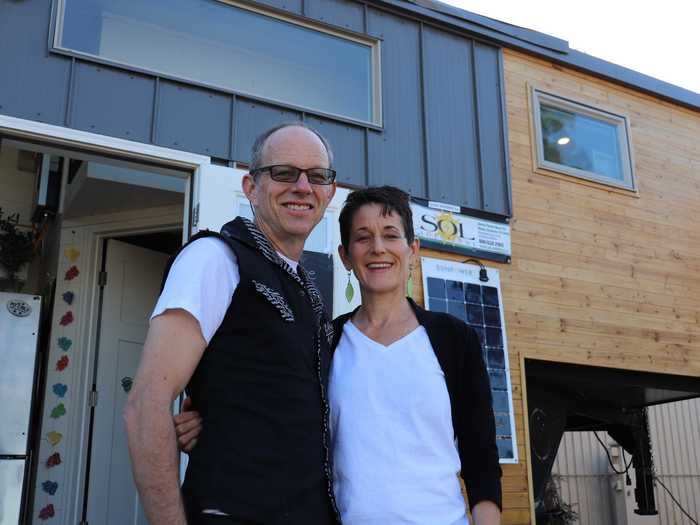
About a week before the lockdown took effect in California, Lindsay and Eric Wood were asked to vacate the property where they parked their tiny house. As most tiny house owners know, this is common, as zoning laws can be especially difficult and strict on tiny houses.
The couple is now living in Lindsay's parents' house, trying to find a new spot to rent for their tiny house, but it's proving to be especially difficult these days. They are only able to look at vacant lots over Zoom calls because of the lockdown orders.
But they are excited to get back in their tiny house as soon as possible because they love the lifestyle.
"We can go right outside a lot sooner than a bigger home," Lindsay told Insider. "My door is a lot closer to the outside world."
READ MORE ARTICLES ON
Popular Right Now
Popular Keywords
Advertisement